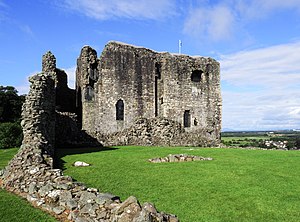Dundonald Castle
| Dundonald Castle | ||
|---|---|---|
|
Dundonald Castle |
||
| Conservation status: | ruin | |
| Geographical location | 55 ° 34 '36.1 " N , 4 ° 35' 49.6" W | |
|
|
||
Dundonald Castle is on a hill above the parish of Dundonald, South Ayrshire , between Kilmarnock and Troon in Scotland . The name means "Donald's fortress"; Historians are unsure of the origin but conclude that it was one of the kings of Strathclyde in the 10th century.
history
Early attachment
Sparse archaeological finds indicate that the hill was used as a castle grounds as early as the 5th century. Buildings made of wood of various sizes and both round and rectangular are to be verified, while a Murus Gallicus served as protection and delimitation of the complex. Around 1000 AD, a fire meant the end of the fortification. The fire destroyed the buildings, the resulting heat must have been so great that parts of the wall were melted or glazed.
Around this date the independence of the Kingdom of Strathclyde also ended; it went up in the Kingdom of Scotland .
Medieval castles
Three different castles from the Middle Ages can be found on the area of the current complex:
The first fortification dates from the 12th century. It is attributed to Walter Fitzalan , the first steward of the Kings of Scotland , who came to Scotland in 1136. From this castle, as from the earlier fortifications, only archaeological traces can be found.
The second castle was built primarily of stone in the late 13th century by Alexander Stewart, 4th High Steward of Scotland , and was one of the largest non-royal structures when it was built. At the beginning of the 14th century, during the Scottish Wars of Independence , it was almost completely destroyed by its owners to prevent unauthorized use - a common practice of this time even for strategically less important buildings. A well and the foundation of a round tower of this complex can still be found in the northwest of today's castle.
The third castle
Dundonald Castle was built for King Robert II on the occasion of his accession to the throne in 1371. He and subsequently his son John (as Robert III ) used it as a royal residence. The builder is Robert Stewart, later 1st Duke of Albany and son of Robert II from his first marriage.
The shape of the castle is considered to be a “fortified tower house ” and was originally three stories high: the ground floor was a possibly divided storage room for food and drinks as well as for heating and fuel. The first floor contained the lower laigh hall , which was used for public functions, festivities and court sessions . On the second floor was the great hall with a towering stone vault , the private use of which was reserved for the king and his family.
In the late 14th century the castle was expanded. She was given additional private rooms and a prison. The inner courtyard, protected by a wall, was completed, and outbuildings (called stables, bakery, brewery and smithy) were built along the wall. A small church was also built and dedicated to St. Inan (probably Ninian ).
The castle today
The ruins that exist today are the derelict remains of the third castle after it was no longer used from the middle of the 16th century. It is owned by South Ayrshire Council and the attached visitor center is operated by The Friends of Dundonald Castle . The entire complex is only open in the summer months, and an exhibition in the visitor center shows the history of the castle and models over time.
Legends
- There is a folk tale in the Ayrshire region , the origin of which can be traced back to a tale from 1001 Nights :
- Donald Din (or Din Donald) was a poor man, but he dreamed happy dreams. One night he dreamed three times that his fate would change if he went to London Bridge. So he followed his dream and met a man on the bridge. He had repeatedly dreamed of a place in Ayrshire where treasure could be found. He declared Donald crazy if he believed in dreams.
- His wife also said he was crazy. In the description of the stranger on the bridge, Donald recognized his own field of cabbage. But only after digging up the field and destroying the entire harvest did he find a large pot of gold. From it Donald built a mighty castle and became the founder of an ambitious family.
- A secret tunnel is said to lead from Dundonald Castle to Seagate Castle in Irvine.
literature
- Gordon Ewart, Dennis Pringle: Dundonald Castle Excavations: 1986-93 . University Press, Edinburgh 2007.
Web links
- Dundonald Castle. Friends of Dundonald Castle, accessed September 21, 2014 .
- Andrew Spratt: Reconstruction of Castle Dundonald. Maybole Community Council, 2001, accessed September 21, 2014 .
- Dundonald Castle. Undiscovered Scotland: The Ultimate Online Guide, accessed January 1, 2014 .
- Entry on Dundonald Castle in Canmore, Historic Environment Scotland database
Individual evidence
- ↑ Arnold F. McJannet: The Royal Burgh of Irvine . Civil Press, Glasgow 1938, pp. 14 .
- ^ Robert Chambers: The popular rhymes of Scotland . W. Hunter, Edinburgh 1826 ( online on Google Books [accessed September 21, 2014]).
- ↑ John Straw Horn: The History of Irvine . John Donald, Edinburgh 1994, ISBN 0-85976-140-1 , pp. 35 .


